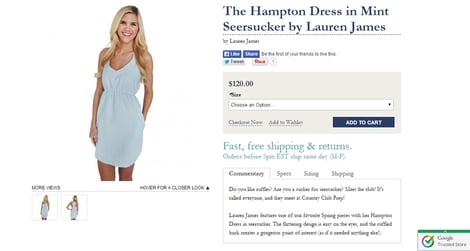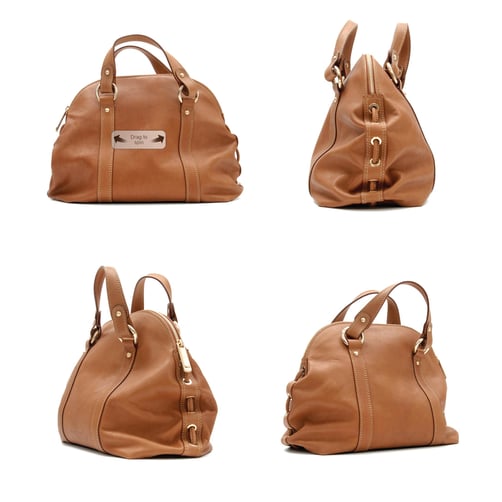4 Months to Better Product Pages

As the holiday retail push seems to start earlier each year, many savvy online retailers are preparing now. Since November and December sales could represent as much as 40 percent of their annual revenues, improved product page design should be one of their top priorities.
Discover several design-related challenges that merchants must address in the upcoming months and a few actionable tips from one smart digital storeowner to get you through the end of the year and put you in a festive, money-making spirit.
Product Page Prep
Every retailer struggles with deciding what information to put on the product page and what to leave out. Including too much info can overwhelm customers, according to Benjamin Utterback, the lead community manager at PrestaShop, but not having enough information can worry a customer due to fear of the unknown.
What is left of July is the perfect time to create a product page wish list, like Country Club Prep, a company experiencing massive growth and aspiring to be the Zappos for preppy clothing, did in its early days. Founders Matt Watson and Stephen Glasgow - classmates in law school - drafted product pages on paper with color pencils and images cut out from other websites (check out a list of wireframe tools). This strategy is on par with advice from PrestaShop.
"The best advice I can give any online store owner is that the next time you are doing your own online shopping, consciously note down in your head or on paper what works for you," said Utterback. "You'd be surprised how similar you are to your own customers. Don't be afraid to test out something new, and always remember that design and content go hand in hand."
August is Content Awareness Month
Since design and content need to work together, including high-quality product images and unique product descriptions are the first to-do items on a retailer's holiday countdown list. Adding high-quality images can be expensive, but retailers can learn a valuable lesson from Country Club Prep, which uses a collection of both manufacturer product images (when they have white backgrounds for consistency purposes) and photos taken in-house (the majority of the model shots, like the one used in image A, are shot in-house). What's particularly unique - and useful- is that under the sizing tab they include that the model is 5'8" and wearing a size small.
This may seem insignificant, but we know that product reviews are extremely influential in purchasing decisions (more on that later); one of the reasons is because shoppers like to compare what their experiences might be like to those who have worn, felt, tried or seen the product. Since Country Club Prep includes the model's height and clothing size, a discerning female shopper would be able to compare her own body type to that of the model's and determine if it would be a good fit/style for them.
Of course there are more technical ways of doing this with virtual fitting room solutions (Fits.me is a popular solution as is PhiSix which was recently acquired by eBay), but retailers who take in-house product or lifestyle images can add their own commentary about the model's height, size and weight to help move holiday shoppers toward purchase.

Image A CountryClubPrep.com boasts four of the five must-have product page elements.
Another way to improve product imagery is by integrating features such as 360-degree spin, slideshows, zoom-in, hover, etc., which can often be used with existing photos. Magic Toolbox, which provides image tools for websites, is a viable option that integrates with BigCommerce, Magento, NetSuite, PrestaShop, Shopify, Volusion, Zen-Cart and other popular platforms (check out its drag-to-spin feature in image B).

Image B Magic Toolbox helps retailers increase conversion through 360-degree product imagery.
With more detailed photos in hand, the second half of August should be dedicated to creating unique product descriptions (ones that aren't copied from manufacturers and ones that tell consumers a product's story). Once again using Country Club Prep as an example, its product commentary is so witty and informative that its customers routinely spend time on the page reading them and sharing them with friends.
A Super Social September
To allow their shoppers to share their products, retailers must include social sharing buttons on product pages, which can provide them with feedback (like what's popular) before holiday shopping even begins. Robust solutions like AddThis can monitor shares (and the messages included in them). Alternatively, retailers can simply get the "button" code from a service like AddtoAny.
More direct feedback, however, can be obtained through customer reviews, just one of the many reasons this feature is a must-have for all ecommerce websites.
"In this day and age of massive social sharing and customer curated content, consumer reviews are imperative," Utterback. "That said, if you don't have customer reviews because you are just starting your store, keep them lower on the page until you have enough to prominently display."
While Country Club Prep has certainly come far from its basement beginnings - like opening up two brick-and-mortar locations this year - its product pages are missing this very valuable feature. Knowing that Country Club Prep uses Magento, it could easily add any one of the Magento Connect product review options such as Yotpo.
October Means Mobile
Equally important as social sharing functionality and user-generated content is mobile responsiveness, as consumers want to shop on whatever device they choose. Failing to optimize e-stores, let alone product pages, for mobile shoppers is a costly mistake according to Utterback. Need proof? Monetate's 2013 holiday roundup indicated that mobile traffic was responsible for almost 40 percent of Black Friday online traffic.
The majority of store builders and ecommerce platforms offer mobile-friendly solutions or responsive Web design, but merchants who need a little more nudging (or help developing) should check out Website Magazine's, "Retailers. How to Get Mobile Now" at wsm.co/mobilenow14.
November Needs Shipping Info
Regardless of device being used, there's nothing that will turn off users more than high or hard-to-find shipping fees. In fact, a UPS study reports shipping and handling fees are the number one cause of shopping cart abandonment, which is why shipping and return policies should be displayed on each product page.
In November, online merchants must strongly consider offering free shipping even if it's for purchases over a certain amount, depending on margins. Alternatively (although not as effective), merchants can provide a shipping fee calculator on the product pages. UPS offers Developer Kit Application Programming Interfaces (APIs), which allow customers to calculate shipping charges, track packages and verify addresses.
The Countdown
The holidays will be here fast but improvements to ecommerce sites take time. Retailers should maximize the next four months by focusing on improving their all-too-important product pages. Most of the five must-haves included here (high-quality product images, unique product descriptions, social sharing buttons, user reviews, and shipping and return policies) are standard to the top Internet retailers' product pages, so your customers are expecting them on your site too.

Subscribe to Our Newsletter!
Latest in Marketing








